by Shihan Anthony Marquez
Even though I was born in America, a large part of meconsiders home to be a place called Okinawa. I can still remember the good old days as a young serviceman walking into a dojo for the first time. I celebrated the 25th anniversary of that day on April 5, 1996. I visited Okinawa in August 1995 and participated in the Pre-World Championship, the precursor to the World Championship scheduled to take place on Okinawa in July 1997.
This visit changed my entire outlook on Okinawan martial arts and, to a large extent, my future! I would like to share this experience with you and I will start by providing some background on my training and teachers.
Prior to arriving in Okinawa for the first time in 1971, I was stationed in Japan with the U.S. Air Force for four years where I was heavily involved in the Yoshukai Karate and Kobudo system headed by Yamamoto Mamuro. I requested transfer to Kadena Air Force Base, Okinawa, and egan a journey that was to last eight wonderful years. During that time, I was honored to have trained with some of the best teachers available. My first and only Karate teacher in Okinawa was the late Shinjo Masanobu, founder of the Shobukan Goju-Ryu Karate Dojo. From Master Shinjo I received a rokudan (6th dan). My first Okinawan Kobudo teacher was the late Kina Masanobu. I met Kina Sensei through another serviceman, Robert Teller, who said that Kina Sensei was an excellent weapons practitioner. Kina Sensei was a devout Christian, the nephew of the legendary Kina Shosei. My training with Kina Sensei lasted approximately 16 months. It was a very gratifying time for me. I had many late night dinners at Kina Sensei’s home with my wife and found that he was a very beautiful person. I learned two katas from Kina Sensei, Ufuchiku no Sai and Tonfa. Unfortunately, he accidentally drowned while swimming in the ocean. Ironically, he was an excellent swimmer, and every Saturday after our workout he would go into the ocean for his daily swim. I never received any rank from him.
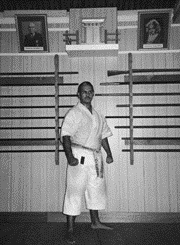
The author, Shihan Anthony Marquez , stands in Sensei Isa’s dojo in Okinawa.
My second and last Kobudo teacher was the late Kanei Katsuyoshi, founder of the Jinbukan. Master Kanei was the finest weapons practitioner I had ever seen. At the time I began training with him, he was the vice president of the Okinawa Kobudo Association, which is headed by the Matayoshi family. I was admitted into his dojo by a formal letter of introduction given to me by my Karate sensei, Shinjo Masanobu. Kanei and Shinjo Senseis were childhood friends. They both were Goju-Ryu Karate students under Toguchi Seikichi. I received a godan (5th dan) and Shihan certification from Master Kanei. I became the US director of the Jinbukan upon my return to the States . Again tragedy was to follow my path for I lost both of these wonderful teachers in 1992 within a period of six months.
My 1995 trip to Okinawa had a two-fold purpose, the first was to take my team of 16 Kobudo and Karate students to visit my old Hombu, the Jinbukan, and see the man who is now in charge of the dojo. The second was to try to find a gentleman by the name of Isa Kaishu. I had heard of Mr. Isa and seen his photographs from my first weapons teacher, Kina Masanobu. It was my understanding that Mr. Isa was an old student under Kina Sensei. During the time I lived on Okinawa, he was in Japan training to become a Buddhist priest. Since Kina Masanobu died while I was on Okinawa, I felt that my weapons training was unfulfilled. The many accounts that I heard of Mr. Isa always stayed with me and I promised myself that on one of my future trips to Okinawa I would look
him up.
The Search Begins
One of the biggest hurdles to overcome when visiting Okinawa is affordable lodging. I had problems finding hotel space for our large group because there were many people on the island for the World Pre-Tournament. During the second day of the championship, I was very fortunate to bump into a gentleman by the name of Dan Smith. I found out through our conversations that we had something in common, since he had also trained in the Jinbukan. I mentioned that I was having difficulties finding lodging and he said that his sensei in Okinawa had a lot of property and he would ask if he could put us up for a few days. As luck would have it, the sensei he was talking about was Shimabukuro Zenpo, the head of Seibukan Shorin-Ryu. It being a small world, one of my black belt students, Angel Lemus from Los Angeles, is also a Seibukan sensei. Shimabukuro Sensei is a very wealthy real estate agent in Okinawa and a very kind and generous individual. He put up our team at no cost in a small double room apartment near his office. We found ourselves sleeping elbow to elbow, which is a very good way to establish a good camaraderie among your fellow students.
In Search of Isa
After the championships were finished, I was ready to look for Isa Kaishu Sensei. At the time, I did not know his first name and I didn’t know if I had his correct address. As a matter of fact, Angel had called me up late the night before our departure to Okinawa and gave me an address for Isa Sensei that he found in Mark Bishop’s book, “Okinawan Karate: Teachers, Styles and Secret Techniques.” I was very fortunate that Mr. Shimabukuro’s office was right across the street from where I was staying in Okinawa City. I walked into his office one day and explained to his secretary that I was trying to find a man named Isa. She then looked up the name Isa in their version of the Yellow Pages and found an address that was about five blocks away. She then asked Mr. Shimabukuro’s nephew, who also works at the real estate office, to take me there.
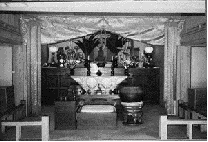
Sensei Isa’s living room was partly converted into a very beautiful Buddhist shrine in which he conducts daily services.
Upon arriving at the address in the phone book, we found that it was not Isa Kaishu Sensei’s dojo or home. It was a Shorin- Ryu dojo but the sensei there knew of Isa and provided us with his home address and phone number. We called this number and to our surprise found Isa Sensei on the other end of the line. The translator then told Isa Sensei that there was someone who was trying to find him. Isa Sensei asked who was I and what did I want? Through the translator, I told Isa Sensei that I was an old student of his sensei, and ever since Kina Sensei’s death I had wanted to find someone from this weapons family and pay my respects. Upon hearing that I was a student of his teacher, Isa Sensei thought that I must be a very, very old man. It turned out that Isa Sensei was a student of Kina Shosei, the uncle of my teacher, Kina Masanobu. I made an appointment to meet with Isa Sensei the following day at 9:30 am.
A Meeting With Destiny
We arrived at Isa Sensei’s home and ironically enough it was directly across the street behind Shimabukuro Sensei’s office and two houses down. I believe now that finding Isa Sensei was something that was meant to be. For not only was Isa Sensei’s house close to where I was staying, but when I went to the first address which was not Isa Sensei’s place and we were given another address, I thanked the driver for his help but that I wasn’t interested in further pursuing this quest to find Isa Kaishu at this time and that I would look him up on my next trip to Okinawa. The driver was very insistent on finding Isa for me and were it not for his persistence I would not have made this very important connection.
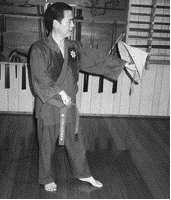
I never dreamed that I would actually find something new in Okinawa during this trip, something ancient and truly mysterious. I thought I had seen it all. Nor had I considered the possibility of finding someone that I could actually empty my cup and bow to. My original intention was to find Isa Sensei and to simply tell him that this American still loved his teacher, practiced his katas, and wanted to reestablish a family tie. That is all I wanted to do. I really came to Okinawa to fill a void that I felt inside when my teacher died. What happened from that point on has changed the course of my weapons training. It was the most enjoyable meeting I have ever had with any Okinawan master, and I have met many of them.

This is the kamae or defensive posture used with the Ufuchiku Sai. Notice that the index finger wraps around the sai handle.(A) The other sai which is in the chambered position is outside and on top of the forearm.
Upon arrival, I was welcomed into a small and modest Okinawan home, as most Okinawan homes are. Upon entering the home, I found that half of the living room was fashioned after some kind of religious shrine. I later found out that Isa Sensei had indeed become a Buddhist priest. During the next three hours while I spoke with him, several people came by and asked for his religious services. They would enter the home, light some incense, and he would offer some kind of prayer. It was strange to see him one minute talking to me and the next minute performing a religious ritual, then resume our conversation.
Isa Sensei is a small Okinawan, about 120 pounds wet, has a very friendly disposition, and is very enthusiastic. There was another gentleman there when I arrived, a senior student of his. I later found out that Isa Sensei had called him prior to my arrival and asked him to be there because he spoke enough English to act as an interpreter; his name was Tamai Moritasu. He was a very educated person and very courteous. I struck up a great rapport with him and he was to be instrumental in the following two weeks in helping to educate me and my students in Isa Sensei’s teachings.
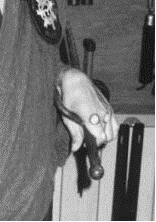
(B) Sensei Isa has perfectly formed round knuckle callouses on both hands. As a matter of fact his hands were photographed and are considered a natoinal treasure and are on on display in the Okinawan Maertial Arts Museum.
While sitting in his tiny living room, Isa Sensei wanted to know what my story was. I told Isa Sensei of my past experiences and who my teachers were. I told him about my old sensei, Kina Masanobu, and that when he died I felt a void not only in my life but also in my weapons training. I wanted to find someone who had studied with Kina Sensei and establish a connection so that whenever I visited Okinawa I could train in his weapons line. At this point, Isa Sensei asked me what I had learned from Kina Sensei. Kina Sensei was also an 8th degree black belt in Shorin-Ryu, but I only studied weapons with him. I was very proud that Kina Sensei had taught me what I believed to be two very rare Kobudo katas from the Ufuchiku lineage, the Ufuchiku no Sai and Tonfa. After mentioning this to Isa Sensei, he looked straight at me and said “No, he never taught you Ufuchiku no Sai or Ufuchiku no Tonfa.” This caught me by surprise and I asked the interpreter to ask Isa Sensei why he said this. His response was that Kina Sensei never taught these katas because he never knew them. “Old man Kina never taught him those katas. I know those katas and I have not taught them to anyone.” Isa Sensei then explained to me his relationship with Kina Masanobu. He and Kina Masanobu were students of the old man, Kina Shosei. The All-Okinawa Karate Federation promoted both of them to 8th dan at the same time. Isa Sensei and Kina Masanobu were both eligible to become third generation inheritors of the Ufuchiku weapons system as passed down by Sanda Kinjo, whose nickname was Ufuchiku, “police chief” in Hogen, the old Okinawan dialect. Kina Shosei chose Isa Sensei to be the Ufuchiku family style head, or soke.
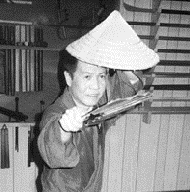
Sensei Isa demonstrates the use the use of the metal fan. Notice how he employs the straw hat to coceal the weapon from an opponent.
This information really confused me because I had had everything backwards. All at once I discovered that Isa was not a student of my teacher, I did not know the Ufuchiku katas I thought I knew, and the original reason for my being in Okinawa no longer existed. I then thought maybe I should leave and I felt very awkward. Isa Sensei asked what else I knew and I said that I had studied Goju under Shinjo Masanobu and weapons under Kanei Katsuyoshi. He immediately gave me his condolences and said that he was very good friends with both of them. He added that it was very sad that both of them died so suddenly and that Okinawa lost two of its greatest martial artists.
Karamiti
Then the most amazing thing happened. Isa Sensei asked me if I had heard of “Karamiti” . I said no, I had not, and I asked him what it was. Keep in mind that we were sitting in a very small living room. I was sitting across from Isa Sensei and his assistant, Mr. Tamai, to his left. For the next 20-30 minutes he proceeded to give me a private demonstration of this thing called “Karamiti.” He asked Mr. Tamai to put his hand on his shoulder and in a flash he took Mr. Tamai’s arm and put it in a joint lock that had his assistant in pain tapping out. Isa Sensei then pointed to his assistant’s wrist joint and said “Karamiti.” This happened so quickly that my eyes felt as if they had been deceived. I had never seen a display of speed such as this in my 25 plus years of experience. I could clearly see the expression of pain on Mr. Tamai’s face and I quickly ruled out the possibility of a staged display or gimmick.
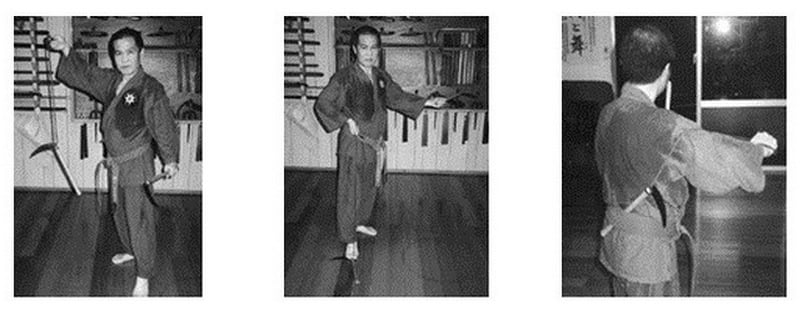
Left: Sensei Isa shows a more practical way to tie a rope to the kama. He said that this way is safer to use and when it is thrown, it will slice the opponent with the sharp edge as opposed to puncturing with the tip. Middle: A deceptive move, ready to go kick the kama up at the opponent. Right: The old way of carrying the kama was to slip it into the obi. This keeps it hidden and it is ready to be pulled out for use. With the string tied to the end of the handle, you could not employ this technique.
Isa Sensei outdid himself for the next half hour by demonstrating more intricate displays of this “Karamiti.” His assistant grabbed, punched, kicked, swung, and just about did every kind of attack possible from various angles. Isa Sensei first demonstrated from a sitting position, then from a standing position. Isa Sensei calmly and swiftly had Mr. Tamai at every turn face down on the floor in serious pain in one joint-lock technique or another. This man was not only in pain, but he was totally drenched in sweat. It was a funny sight to see, for he was wearing a business suit and tie and he was punching and kicking in full force. I was sweating just watching. Isa Sensei gave his assistant instructions to grab here or there, punch to the face or to the body. However, he also allowed Mr. Tamai to attack at will with any technique whatsoever. The variations he used were continuous. To do this in a small enclosure from a distance of about 3 feet, not having the spaciousness of a dojo, was truly amazing. Isa Sensei was in full control of this man. He threw Mr. Tamai around the room yet nothing was disturbed or broken. Throughout the demonstration, nothing was overdone, Isa Sensei was in complete control putting Mr. Tamai in a position where there was just enough applied pain to force him to tap out. I was to find out later how Mr. Tamai felt when these same techniques were to be applied on me.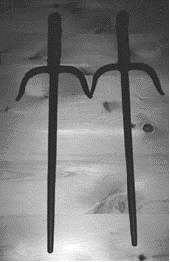
I wondered why he was even showing this to me. In all my years of training under some very notable teachers as well as having seen Judo, Aikido, Jujutsu, and Taijutsu, I had never seen anyone apply joint locks with such ease and speed and afflict so much pain in such a short time. I said to myself at that moment, “I would love to study whatever this is!” I was so impressed by this small Okinawan master that my original reasons for visiting Isa Sensei were long out of my mind. After he finished the demonstration, Isa Sensei said this was what he called “Karamiti.” I told him that in the time I had spent on Okinawa, I had seen every style available; seen dozens of demonstrations; shot hours of video; even my Goju sensei, Shinjo Masanobu, had taken me to many private events, training sessions, and demonstrations that were not open to the public, yet I had never seen nor heard of “Karamiti.” So I asked him dozens of questions about its history, others who knew the system, whether or not there was a systematic way of learning it, and so on. Isa Sensei said that it was getting late and we should make another appointment to continue. At that moment, I realized that I had told my team of black belts that I would return in half an hour and it was now four hours later.
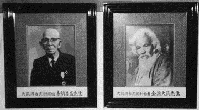
Left: Kanagusuku Ufuchku, born May 7, 1829, died Oct. 13, 1920 at the age of 91. He was employed by the last Emperor of the Ryukyu Kingdom as a bodygaurd and was also the Shuri Chief of Police. Right: Shosei Kina, born January 5, 1981 at the age of 99. At the age of 20, Kina began training with Ufuchiku Sensei for 18 years untl Ufuchiku’s death.
A New Weapons Connection
During the meeting, I noticed that there were dozens of weapons hanging on the living room walls. Isa Sensei had sai, kama, tonfa, nunchaku, etc. … and they looked old. As an ardent weapons practitioner, I couldn’t leave without asking about them. He talked about each of them briefly and then handed me a pair of very old and extremely heavy sai and said Ufuchiku Sensei confiscated them from a bandit. Until now, Ufuchiku was just the name of some katas and a picture of a man I had seen in history books. I was beginning to realize more and more that this connection I was making with Isa Sensei was more than just another meeting with another Okinawan sensei. I felt a bond with him. I felt I could trust and respect him and, to my delight, I felt the same in return from him.
Isa Sensei told me about his lineage and historical connection to Ufuchiku Kobujutsu. Isa Sensei was the third generation of the Ufuchiku line. He had inherited the whole weapons system and Karamiti. During the transmission ceremony, his sensei, Kina Shosei, had passed down to him these sai that had belonged to Ufuchiku Sensei. Isa Sensei then told me a little about his martial arts experience. Isa Sensei began to practice Karate at age three and was taught by his grandfather in the village of Shimabukuro. He had two teachers after that who were both students of Ufuchiku Sensei, Kina Shosei and Tokashiki Saburo. At age eight, he became a student of Kina Shosei of the same village. From Kina Sensei he learned Shorin-Ryu Karate and Ufuchiku Kobudo. Kina Shosei was a very small man and a soft and kind person.
Isa Sensei’s third teacher, Tokashiki Saburo, was a very large and powerful man who was very strict and harsh in his training. Tokashiki Sensei taught Isa Sensei the practical bunkai for the Kobudo and Karamiti systems. Tokashiki Sensei was also a student of Ufuchiku Sensei but there are no pictures of him in any known history books. This is because during one of the training sessions that Tokashiki had with Ufuchiku Sensei, Ufuchiku accidentally cut his face open diagonally from forehead to chin with a sword. Tokashiki survived but not without a very nasty scar. After this, Tokashiki Sensei understandably became camera shy.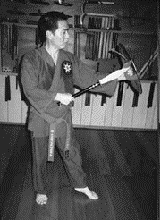 He forbade any pictures be taken of him. Once, Isa Sensei took a picture of him and Tokashiki Sensei ripped the camera from his hands and proceeded to tear it into pieces. Tokashiki Sensei admonished Isa to never do that again, and Isa wisely promised that he would not.
He forbade any pictures be taken of him. Once, Isa Sensei took a picture of him and Tokashiki Sensei ripped the camera from his hands and proceeded to tear it into pieces. Tokashiki Sensei admonished Isa to never do that again, and Isa wisely promised that he would not.
Isa Sensei began to show me pictures of him with Kina Sensei accepting the title of third generation soke. Then he showed me a picture of a very lovely, nice looking woman dressed in traditional Okinawan clothing posing in a movement from a classical dance. As I was looking at it, I asked myself, “Why is he showing this to me.” Then Isa Sensei told me that it was him! He told me that he also has master’s rank in traditional Okinawan dance or “mai” and is the inheritor of that dance tradition as well. He then showed me another picture and a certificate. This picture was of him and his dance teacher accepting the title of soke and his master’s certificate.
A Very Serious Talk
To understand what happened next, I need to explain some feelings that I had stirring inside me while all this was going on with Isa Sensei. After the Pre-World-Championships, I was very angry and disappointed. The championships were a fraud, it was the worst thing I had ever seen. There was systematic cheating on Okinawa’s part and a person had died during the competition. It was a total flop and a disgrace.

Sensei Isa demonstrates a technique of hiding the short blade of the Tinbe behind the shield. In this case the shield also serves as a hat. Using the shield to block the blade is suddenly thrust into an attack.
Our conversation turned to the subject of rank. I told him that my rank was earned by working and sweating very hard. I asked him how he felt about people buying rank from Okinawan senseis. I told him that Okinawa had become a paper mill of high-ranking diplomas. Isa nodded in affirmation and said, “You’re right, some Okinawan senseis have sold out.” He said, “You train hard, you get rank,” it was as simple as that. What truly blew me away is that he said that no money would ever be exchanged between us. He was not interested in money for his lessons. It was at that very moment that I made a deep connection with Isa Sensei. I saw in him the old virtues that we all read about in the history books. I was very emotionally involved in the subject of this conversation. After losing both of my teachers who were truly great men, I was not sure if there was anyone left in Okinawa that I could call Sensei again.
However, as I sat in front of this man who was being honest and open with me, showed no vanity about the fact that he was a legitimate 10th dan, and had shown me more in half an hour than I had learned in years, I thought, “Maybe there is someone left on Okinawa worth following.”
The Karate and Dance Connection
After the talk about rank, the atmosphere became relaxed and Isa Sensei began to explain to me the connection between traditional Okinawan dance and Karamiti. He said Karamiti is what Karate used to look like before it became what it is today. There were no such things as high, middle, or low blocks; there were no horse, cat, or back stances, these were things that were developed to create a system called “Te” or “Ti.” The old Karamiti was lost at the time that Karate was openly introduced to the general public. (Unfortunately, during this meeting I did not get into details with Isa Sensei as to a timeline regarding this information. This is something that I plan to do the next time I meet with him.) Like weaponry, Karamiti was studied to defend and preserve life. After the Meiji restoration and the modernization of the country, people no longer needed to protect themselves as in the past. So, because the old ways of training were too severe and painful for the average person, this emphasis was gone. People were rejecting the old ways and the teachers of the time had to consciously formulate a system that was easier and safer to learn. This has also happened in America. Very few people today want to pay the price for that kind of training anymore. The old masters had to water down the old ways and make it more consumable.
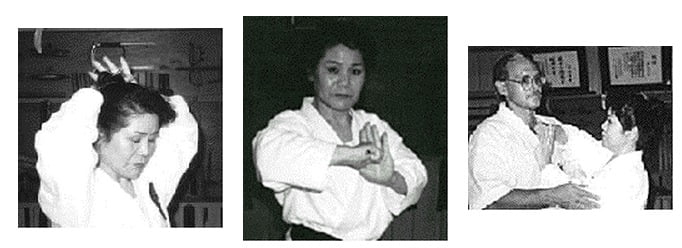
One of Sensei Isa’s top female students, shows the traditional use of the hairpin. It was easily removed and used as a very effective weapon. The author gets the point of the demonstration (far right)
Isa Sensei then began to link the old Okinawan dance to the Karamiti. He said that in the old days they couldn’t practice openly because of the Japanese ban on martial arts in Okinawa. So they began to incorporate Karamiti movements into the old dances and no one could tell that they were actually practicing fighting movements and thus were able to teach it to future generations. I had heard about this in history books and both my past teachers had mentioned it, so this wasn’t new. However, no one had ever actually demonstrated this to me in the flesh. In later training sessions in his dojo, Isa Sensei would show us a dance move and he would ask his assistant to punch, then Isa Sensei would do the same dance move as a multidimensional defense. It had a block, a strike, a joint lock, and finally a takedown. It was incredible to see a movement that was so smooth and beautiful in a dance, applied by someone who knew what they were doing, become such an awesome and effective movement of personal defense. For the first time I could actually see the connection between the old Karate and the old dance. It was a great connection for me because it filled a void that existed in my personal training. This is something that my Goju sensei, Shinjo Masanobu, told me, saying that the old timers had a form of self-defense that was now lost in Okinawa. He told me he had heard about it but he did not know it. Most if not all of the other senseis of his generation in Okinawa did not know it either. He added, we do our bunkai from a modern perspective, we did not learn the old bunkai of kata. Those old techniques died with the past generations, everything we have nowadays we had to basically make up and do the best job we could with what we had.
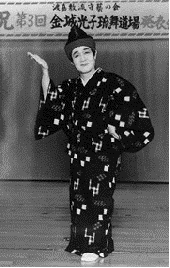
A very lovely looking Sensei Isa dressed as a woman with makeup during a traditional Okinawan dance demonstration.
I believe that any honest karateka today can look at the curriculum he or she has been practicing for the last 10 or 20 years and say that something is missing. Analyzing what Isa Sensei had just told me about teachers taking a form of training and repackaging it to make it more palatable to the general public rang a bell in my head. I put two and two together and realized that what the old Okinawan masters did back then is what some GIs did upon returning to the U.S.A. after their tour of duty. We (non- Orientals) have been told by our Oriental teachers that we were not to change the katas or anything else. However, they themselves did what they told us not to do. We Americans have been doing this for years. We’ve done it for lack of information or because we only received the “tip of the iceberg.” Let’s face it, most GIs were in Okinawa one or two years, and there’s so much (or little) one can learn in such a limited time. Let’s not forget to also acknowledge that as in every culture, there are charlatans, and Okinawa is not immune to this human condition. Some Okinawan teachers who had very little training sold us Americans the Okinawan equivalent of the London Bridge.
Isa Sensei continued to tell me that it was foolish for today’s modern practitioners to practice 20 or 30 years worth of high and middle blocks. At face value, these techniques are not applicable in the real world. Eventually, we would have to find a way of defending ourselves in a system that was not so enclosed with such limited parameters.
In later training sessions, Isa Sensei proved everything he told me by actually demonstrating every point to me. He asked me to demonstrate my Goju, which I did, and he said that my Goju was very strong, “good kihon waza.” However, he added that this was no good for fighting. So I asked him to please show me, and so he did.
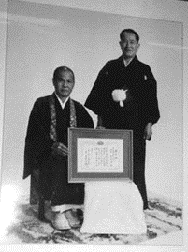
Kaishu Isa seated next to his dance teacher as he receives his masters certificate for Traditional Okinawan Dance.
He not only demonstrated on me, but on the other six members of my group. These men varied from 5′ 6,’ 135 pounds to 6’6,’ 285 pounds. Keep in mind that we are all seasoned Goju practitioners that are in excellent cardiovascular condition, and are physically very strong as a result of good Goju training. After Isa Sensei quickly dispatched me, he then took every member of my group from the smallest to the biggest and did the same with them. He would tap certain areas on their bodies and these big strong men would turn into jelly and then he would put them into a joint lock and take them down to the floor. It was very interesting to see that these techniques worked on everyone, it did not matter your size, weight, or strength. I shot hours of video of Isa Sensei effortlessly applying dozen of variations of these techniques. I can certainly say now without any hesitation that the void in my training is no more. I have found what I was looking for and it puts me right back in the place I’ve been before, that is, coming full circle, I am now ready to learn the old ways, so I am a beginner once again.
The Rest of the Trip
I spent two weeks training with Isa Sensei. We began around 8 PM and trained until 2 or 3 in the morning. During the day, he was busy tending to his priestly duties, and I kept my other appointments. I decided to pose a question to all the other senseis that I met: “Have you ever heard of Karamiti?”The responses I received were very interesting. When I met with Nakamoto Masahiro Sensei, he said he teaches it in his dojo and he gave me a little demonstration of his form of Karamiti, but he was nowhere close to Isa Sensei’s proficiency. When I asked Matayoshi Shinpo Sensei, he said he had never heard of it. Shimabukuro Zenpo Sensei said that Karamiti was a very old form of Karate that his father, Shimabukuro Zenryo (founder of the Seibukan), was very familiar with, but he himself was not. This was confirmation from other sources of what Isa Sensei had told me: some senseis had never heard of it, others had heard of it but didn’t know it, and still others know some it and teach it.
Feel the Pain
Back with Isa Sensei at his dojo, he used his senior student as a guinea pig to demonstrate most of the techniques. We were very grateful to Mr. Tamai for he gave of himself freely and without complaint to the abuse he received for those two weeks for our benefit.
Isa Sensei was very careful when he demonstrated on me. He used very little pressure, and I wanted more because I know that to learn something properly one must feel it. Specially when it came to this form of training. I later found out Isa Sensei felt obligated not to shame me in front of my seniors. It was very gratifying to meet someone that practiced dojo ethics like Isa Sensei. He didn’t want to toss me around so he told me to stand behind the videocamera and shoot. That’s why in my videos you mostly see Clay Allison Sensei who stayed with me when the rest of the group returned to the States. Allison Sensei was so amazed with what he saw that he asked me if he could stay after the main group left. Mr. Allison is about 6′-3′ tall and weights about 220 pounds of solid muscle. It was amusing to see him tossed around for the next week and a half by someone one third his body size. Isa Sensei was literally playing with him and yet I could clearly see that Mr. Allison was in pain every time. At times, a part of me wished that I could be out there on the receiving end. But then, another part of me said, I really don’t want to be out there, so stay behind the camera. During this time, Isa Sensei not only gave us a thorough demonstration of Karamiti but he also taught us some of the basics of Karamiti, which I still practice. These exercises show you different blocks, strikes, and footwork that prepare you for the actual Karamiti.
During this training period, we also spent about half the time training with weapons. Isa Sensei again demonstrated a depth of knowledge on the proper “realistic” usage of weapons the likes of which I had never seen. He was just as knowledgeable with weapons as with Karamiti, and he proved every point that he spoke of with physical examples. This type of training made me realize that without this knowledge, any weapons training is very crude and misleading to the practitioner. Isa Sensei said that the Ufuchiku system has over 25 weapons and about 100 weapons katas. I have been involved in weapons for a long time and I could think of about 13 weapons, so I asked him if he could show me the 25 and he did. He showed me some very old weapons that I had never seen before and I photographed each of them. He said that each of these weapons had katas to go with them.
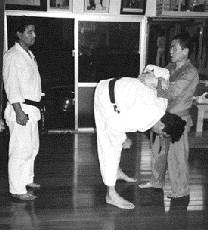
Sensei Isa’s senior student Tamae watches as Isa Sensei place Mr. Clay Allisonin a position which he became very familiar with.
Isa Sensei told me that most practitioners nowadays know only a fraction of the knowledge that is available not only in weapons, but also in the empty hand methods. Every day a piece of history dies with someone. He asked me if I learned everything that my Goju sensei knew? I told him no. He said like both of my teachers that died so young, there have been hundreds of Okinawan martial artists that took to the grave many of the old techniques and katas. This void of information is becoming greater from one generation to the next, and what happens is that the new generation of Karate instructors, lacking this knowledge, fills in the gaps with their own interpretations and passes this on to the next generation, thus the face of Karate in Okinawa today looks nothing like it did 100 years ago. The sad thing is that the old ways will be lost with this next generation, according to Isa Sensei.
The Future Looks Bright
This experience has refueled my thirst for new knowledge and has motivated me to work harder than I have ever done. It has also shown me that my original suspicions were correct about a void in my training. There is so much to learn that one cannot truly say that he or she has reached the top. The moment you stop training and researching is the moment you stagnate and die. We as martial artists have the burden of seeking the knowledge that is already lost and being lost everyday. I found my “holy grail” of Karate and Kobudo by meeting Isa Sensei. I learned a lot and I have been diligently practicing. I made a promise to Isa Sensei that I will return to visit him and discuss our future relationship and to do a lot of training. I will also gather historical information that I will put to use in part two of this article. Stay tuned for more!
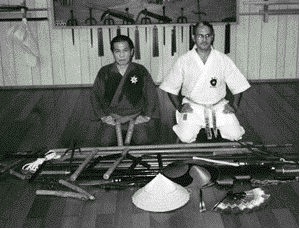
The autor Anthony Marques sits with Sensei Isa with the entire collection of 25 weapons used in the Ufuchiku system.
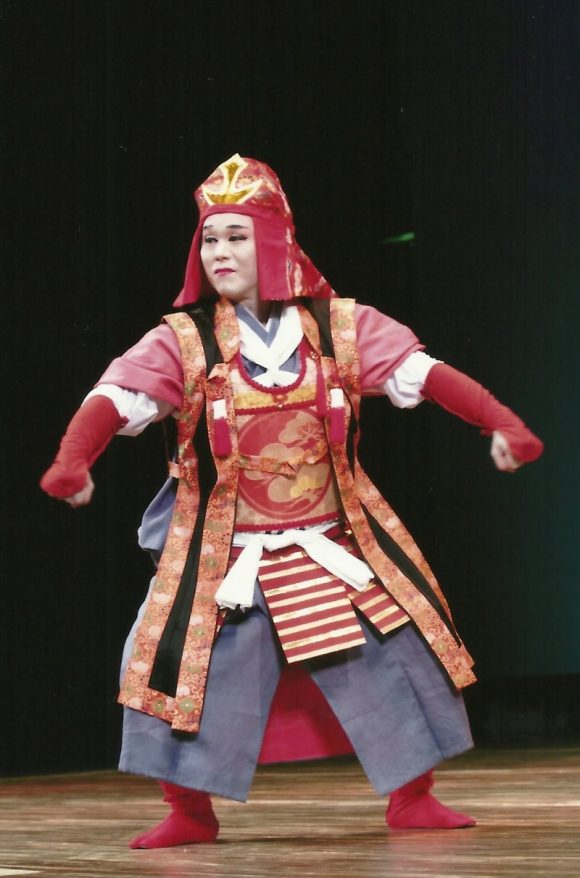
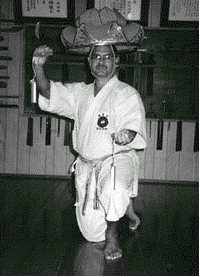
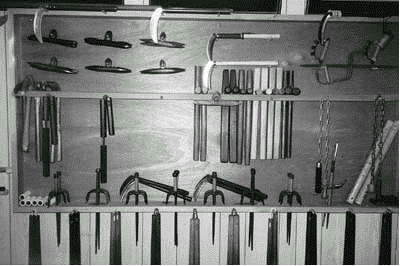
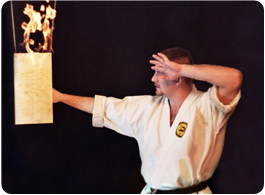

I loved this article. Thank you for having it.
Prince Loeffler
Shugyokan Dojo
alljapankarate.com
This is awesome and your dedication to Okinawan Karate inspires me. Thank you so much!
Hi,
Congratulations for this magnificent rresearch.
I would like to know if Kiichi Nakamoto sensei is related to Sensei Isa in a matter of kobudo lineage, or if they were both students of Kina Shosei O’Sensei and followed diferent ways.
Thank you very much.
José
Nicely organized and informative. Thank you for sharing; nifee debiru.